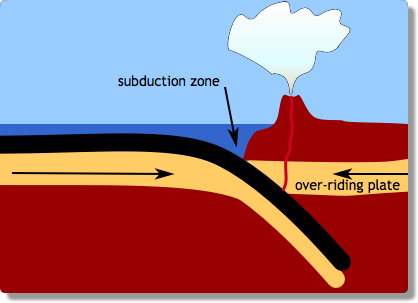
|

|


Paleoclimate
Cretaceous Climate (144 to 65 million years ago)
A decreased source of CO2, a greenhouse gas, because of plate tectonics
 The Earth's crust is made of several sections, called plates, that move around
and bump into one another. When plates run into each other, sometimes one plate
goes under the other. This point is called a
subduction zone. The plate that goes below the Earth's surface melts, and
volcanos form on the over-riding plate as you can see from the illustration.
The Earth's crust is made of several sections, called plates, that move around
and bump into one another. When plates run into each other, sometimes one plate
goes under the other. This point is called a
subduction zone. The plate that goes below the Earth's surface melts, and
volcanos form on the over-riding plate as you can see from the illustration.
Over the last 100 million years, geologists believe that plate tectonics has slowed down. This would lead to less volcanism, and less release of greenhouse gases like carbon dioxide into the atmosphere.
Next page -> cretaceous climate, continued
Links and resources
Cretaceous Climate (144 to 65 million years ago)
A decreased source of CO2, a greenhouse gas, because of plate tectonics
 The Earth's crust is made of several sections, called plates, that move around
and bump into one another. When plates run into each other, sometimes one plate
goes under the other. This point is called a
subduction zone. The plate that goes below the Earth's surface melts, and
volcanos form on the over-riding plate as you can see from the illustration.
The Earth's crust is made of several sections, called plates, that move around
and bump into one another. When plates run into each other, sometimes one plate
goes under the other. This point is called a
subduction zone. The plate that goes below the Earth's surface melts, and
volcanos form on the over-riding plate as you can see from the illustration.Over the last 100 million years, geologists believe that plate tectonics has slowed down. This would lead to less volcanism, and less release of greenhouse gases like carbon dioxide into the atmosphere.
Next page -> cretaceous climate, continued
Links and resources
